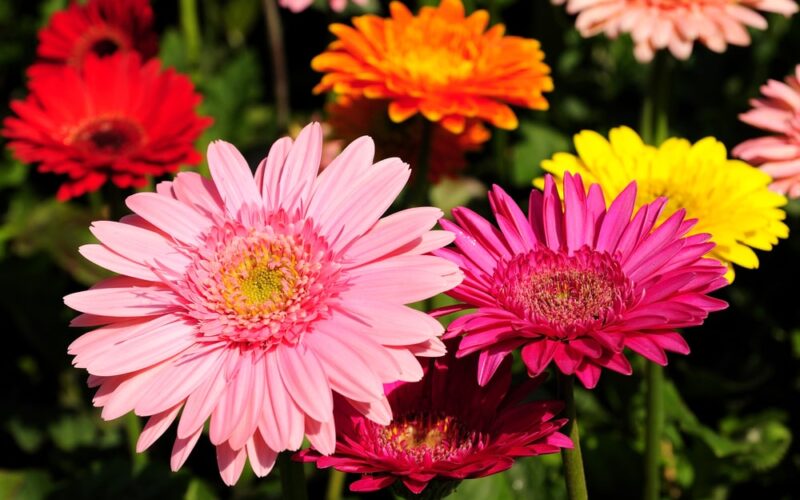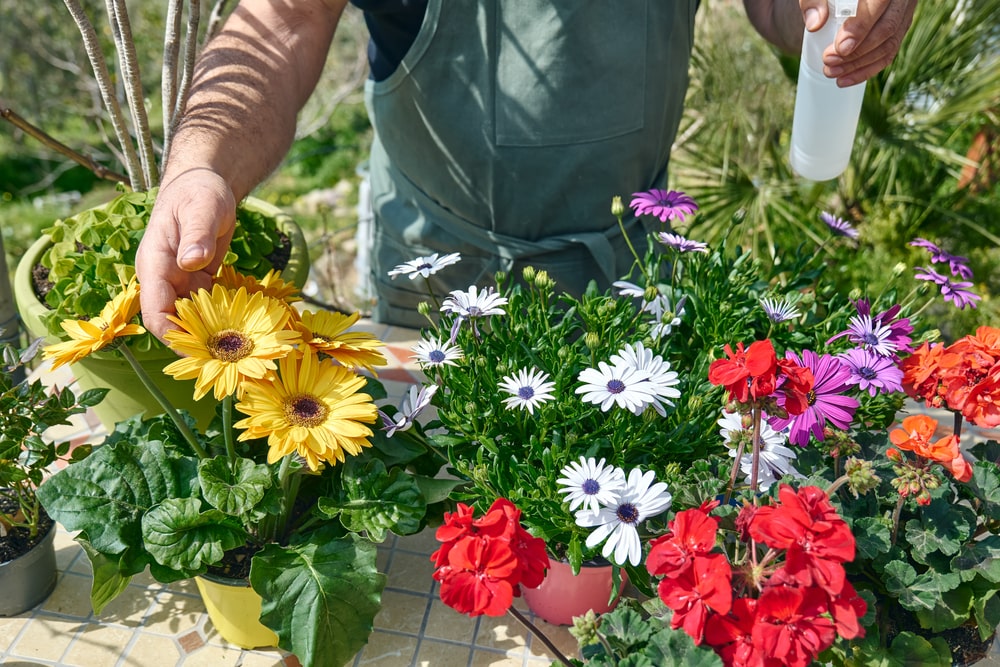A Guide to Gerbera Daisy Care

Gerbera daisies, also called African, Barberton, Transvaal, and Veldt daisies, are tender flowers with deep roots.
They have dandelion-like leaves in rosettes and are covered with down. Known for their vibrant colors, Gerbera daisies brighten any garden with reds, yellows, oranges, pinks, and whites.
We’re breaking down how to successfully grow them and tips for Gerbera daisy care throughout the year.
Gerbera Daisy Types
1. Single Flower
Single flower Gerbera daisies are the most common. They have a single row of long, thin petals that do not overlap surrounding a smaller ring of disk-shaped flowers in the center.
2. Semi-Double Flower
Semi-double Gerbera daisies have two to three times more petals than single flower Gerbera daisies, but not quite as many as double-type flowers.
3. Double Flower
Double-type Gerbera daisies are double-petalled and include not only double but crested and fully-crested varieties of Gerbera daisies. Double-type flowers have one or more rows of petals, called ray flowers, and a compact group of disk flowers in the center.
- Terracotta varieties, for example, are double-type Gerbera daisy flowers with double yellow petals and a splash of peach surrounding their dark red eyes.
- Winter Queens, a crested variety, have white petals and a black central eye.
- Giant spinners, a fully-crested double Gerbera daisy variety, have two rows of outer petals and two rows of inner petals. The first row of inner petals surrounds and covers the eye at the center.
4. Spider Flower
Spider type Gerbera daisies are known for their spiky looking petals. They are ornamental plants that look beautiful as cut flowers.

How to Grow Gerbera Daisies
You can grow Gerbera daisies from seeds or divisions. We’ll break down how to do both.
Gerbera Daisy Seeds
To grow Gerbera daisies from seeds, plant your seeds indoors 12 to 18 weeks before the last frost date in your area. Sow seeds in peat or paper pots so you don’t disturb the daisies’ roots during transplanting.
Press your seeds gently on top of your soil mixture. Don’t cover them completely because they will need sunlight to germinate.
Cover your pots with plastic wrap or a lid to trap moisture in your soil. Place the seeds in a sunny spot. 70 to 75 degrees is the ideal temperature for Gerbera daisies. Then wait 2-4 weeks for your seeds to germinate.
Gerbera Daisy Seedlings
After your last frost date, move your Gerbera daisy seedlings outside. We recommend finding a well-draining site with lots of sunlight to provide the best Gerbera daisy care. Plant the seedlings in the ground so that the crown is ½ inch above the soil line.
Gerbera Daisy Divided Plants
Dividing mature Gerbera daisies helps to maintain air circulation around the plant and promotes flowering.
How to Divide Gerbera Daisies in 4 Easy Steps:
1) Divide daisies in early spring with a sterilized knife or pruning snips, new soil, and a new, clean pot with a drainage hole.
2) Dig out the daisies from their growing medium. Cut through the roots with a knife or snips, separating the root ball into two parts.
3) Replant each part in its permanent location, using a soil type similar to its current soil.
4) Water each division thoroughly.
Do Gerbera Daisies Come Back?
Locally in Pennsylvania, Gerbera daisies are an annual plant. It’s best to plant Gerbera daisies in the spring after your last frost.

Gerbera Daisy Care: Water, Soil, and Sunlight Tips
Gerbera Daisy Water Requirements
Gerbera daisies need regular watering (around 1 inch per week). You should only water them when the soil is dried about an inch or two below the surface.
Gerbera daisies might also need frequent watering when first getting established in your garden and during droughts.
You don’t want to overwater Gerbera daisies in the winter. Overwintered daisies go dormant and only need light watering once a month during this period.
Gerbera Daisy Soil Type
Gerbera daisy soil beds should be made up of well-draining, rich soil containing high organic matter.
Soil pH should be between 5.5 and 6.5. If the pH is higher than 6.5, this can cause chlorosis, in which yellow stripes develop on the leaves. If the pH is lower than 5.5, black spots may appear on the leaves as well.
Gerbera Daisy Sun or Shade?
Sun! Gerbera daisies thrive under full sun exposure, but not intense heat.
Depending on how hot your summers get, plant your Gerbera daisies in an area that offers some shade to protect them against oppressive midday heat. The Gerbera daisy also makes a nice house plant if you have a window that receives lots of sunlight.
Gerbera Daisy Problems
Gerbera Daisy Diseases
Root rot, crown rot, and powdery mildew can affect Gerbera daisies when their soil is too wet.
To avoid these problems, allow the soil to dry between waterings, but don’t leave the daisies unwatered for so long that they wilt and become stressed.
Gerbera Daisy Pests
Spider mites, aphids, whiteflies, and thrips all eat Gerbera daisy leaves. These pests are attracted to stressed plants, so keep your daisies in good health to avoid issues.
Small populations of pests can be eradicated with a strong spray of water. Larger populations can be controlled with insecticidal soap or natural horticultural oils.
Need some help with Gerbera daisy care? Contact your local Home & Garden Center to speak with our in-store experts for all of your gardening needs.
This blog was originally published on March 18, 2016. It was updated on May 4, 2023.
